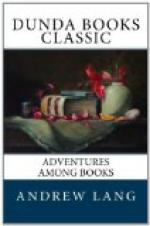On leaving school at seventeen I went to St. Leonard’s Hall, in the University of St. Andrews. That is the oldest of Scotch universities, and was founded by a papal bull. St. Leonard’s Hall, after having been a hospitium for pilgrims, a home for old ladies (about 1500), and a college in the University, was now a kind of cross between a master’s house at school, and, as before 1750, a college. We had more liberty than schoolboys, less than English undergraduates. In the Scotch universities the men live scattered, in lodgings, and only recently, at St. Andrews, have they begun to dine together in hall. We had a common roof, common dinners, wore scarlet gowns, possessed football and cricket clubs, and started, of course, a kind of weekly magazine. It was only a manuscript affair, and was profusely illustrated. For the only time in my life, I was now an editor, under a sub-editor, who kept me up to my work, and cut out my fine passages. The editor’s duty was to write most of the magazine—to write essays, reviews (of books by the professors, very severe), novels, short stories, poems, translations, also to illustrate these, and to “fag” his friends for “copy” and drawings. A deplorable flippancy seems, as far as one remembers, to have been the chief characteristic of the periodical—flippancy and an abundant use of the supernatural. These were the days of Lord’ Lytton’s “Strange Story,” which I continue to think a most satisfactory romance. Inspired by Lord Lytton, and aided by the University library, I read Cornelius Agrippa, Trithemius, Petrus de Abano, Michael Scott, and struggled with Iamblichus and Plotinus.
These are really but disappointing writers. It soon became evident enough that the devil was not to be raised by their prescriptions, that the philosopher’s stone was beyond the reach of the amateur. Iamblichus is particularly obscure and tedious. To any young beginner I would recommend Petrus de Abano, as the most adequate and gruesome of the school, for “real deevilry and pleesure,” while in the wilderness of Plotinus there are many beautiful passages and lofty speculations. Two winters in the Northern University, with the seamy side of school life left behind, among the kindest of professors—Mr. Sellar, Mr. Ferrier, Mr. Shairp—in the society of the warden, Mr. Rhoades, and of many dear old friends, are the happiest time in my life. This was true literary leisure, even if it was not too well employed, and the religio loci should




